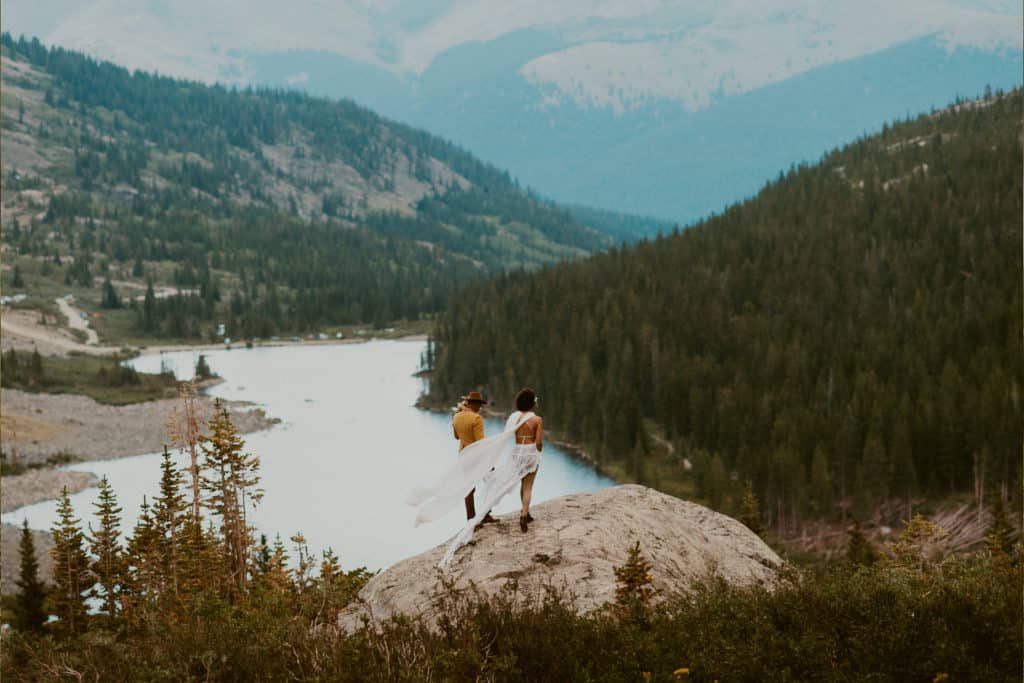
Post Summary: Are you ready to embark on an adventure elopement of a lifetime? Then you’ll want to read up on the leave no trace principles! When you visit a national or state park, you have to treat the great outdoors with care as you explore & appreciate your favorite location on the best day of your life. If you’re about to get married, this is the elopement planning guide for you! Below, you’ll find a full list of the leave no trace principles & learn more about how you can honor them while celebrating your elopement in the beauty of nature.
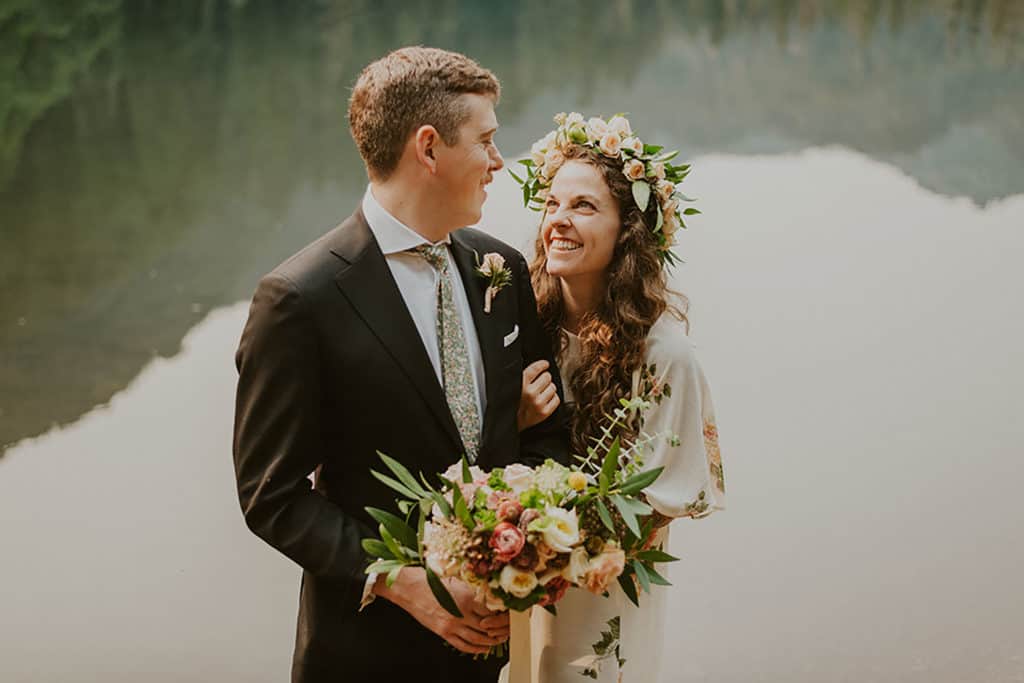
Growing up, I was obsessed with hiking, camping, and exploring, so naturally, I became an adventure elopement photographer! These days, most of my sessions are in the great outdoors— everything from engagements, elopements, intimate weddings, and adventure sessions. My couples loooove going on an unforgettable adventure in the outdoors. We all love nature, right? But most of the time we have no idea how much our behavior affects the environment. That’s when we cause the most damage to our national parks.
While we don’t have the intent to harm wildlife or nature, we still have an impact on the world around us every time we’re out in it. Litter kills animals, walking erodes trailheads, and waste pollutes water sources until the incredible places we love are no longer recognizable, let alone lasting for generations. When photographers are responsible not only for the location recommendations they give their couples but also how they treat the outdoors, that leaves a lot of gray area for damaging the environment while on location.
Just think of the alpine tundra of Rocky Mountain National Park, the hot springs in Yellowstone, the cryptobiotic soil in Moab. Imagine what it would be like if those natural wonders were no longer around. That would be the worst possibility. We can’t let that happen! Mother nature can’t pick up after us, so we need to take care of her ourselves even as we explore & appreciate our favorite outdoor locations.
Luckily, there’s a way to plan an elopement that honors nature: The leave no trace principles, a set of 7 ways to minimally impact the environment when you’re in the outdoors. This framework gives us everything we need to be conscious, respectful citizens of our national parks and outdoor areas. They were created to ensure we protect, enjoy, and love nature. And these principles are easily applicable to elopements!
Read on for a leave no trace planning guide for your elopement.
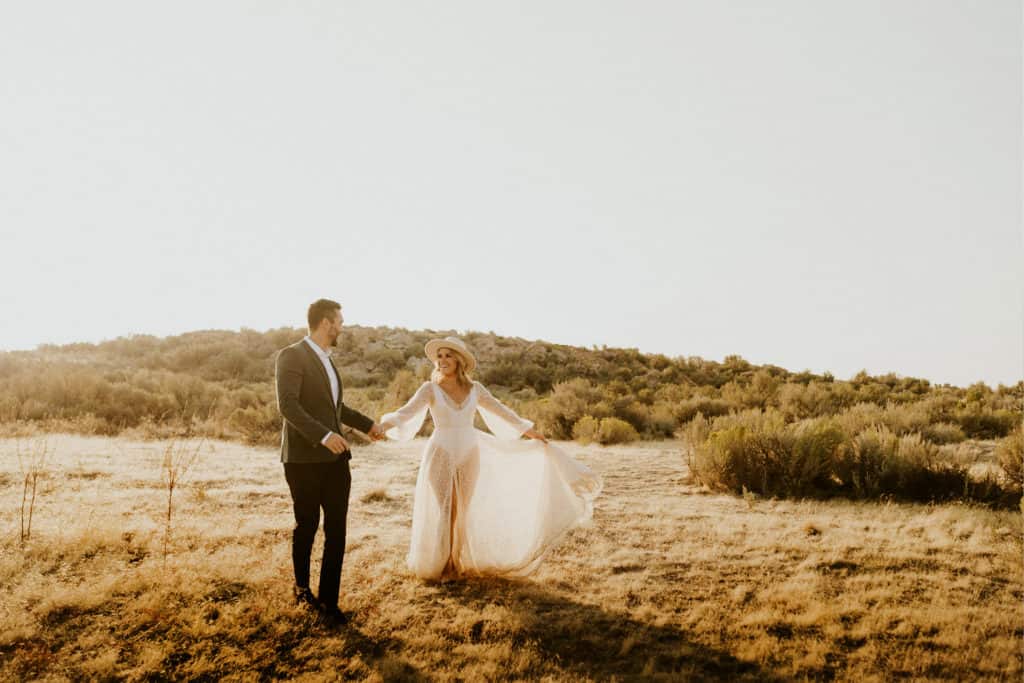
LNT #1: Plan Ahead & Prepare
Most elopements take place on weekdays for a simple reason: Leave no trace photographers schedule their elopements this way to minimize the environmental impact because national & state parks are less busy on these days. It’s great for your images & for the environment, which can only handle so many visitors at a time! But that’s just the beginning of making a solid elopement plan.
When planning for your elopement, the best thing you can do is think about what you’re wearing and bringing. You may have the perfect dress or suit all picked out but you’ll definitely want to bring extra layers, comfortable shoes, and all the gear, water, & food you’ll need to get to your location. An emergency first-aid kit is also a smart idea. Not only is this great planning but it also ensures that you’re trekking comfortably through the environment. When you plan ahead and prepare, it’s so much easier to minimize damage to the land while making your trip safer.
Before you go, never venture without first downloading trail maps, checking weather conditions & road closures, and confirming cell phone service is available (if not, you’ll want to print out that map!). Also make sure the park is dog-friendly if you want to include pets! And always, always, always have a plan B! When it comes to elopements, this is a must.
Finally, you’ll need to call your desired national or state park for permits, check with park rangers for weather conditions & closures, and research the trails you’re taking. If you choose me as your elopement photographer, I help with all of these!
LNT #2: Travel & Camp on Durable Surfaces
Eloping means you can backpack anywhere in the world and get married somewhere incredibly remote just to get that gorgeous view! But that doesn’t mean you should go off the beaten path just to make that happen. You should always hike on trails to reduce foot traffic to a handful of areas (and don’t even think about trespassing on closed roads or trails!). When hikers embark on different paths, this increases the likelihood of scarring and defacing the landscape when we should really be focused on moving through natural areas safely and minimally. You never know if an area is closed for reconstruction or restoration, and trampling through it will probably hurt those efforts.
When you’re camping, stick to existing campsites and set up camp on durable surfaces like dirt, rock, gravel, or grass and never pitch up a tent on flowers or lichen. For more on choosing a great campsite, hit up the Leave No Trace website!
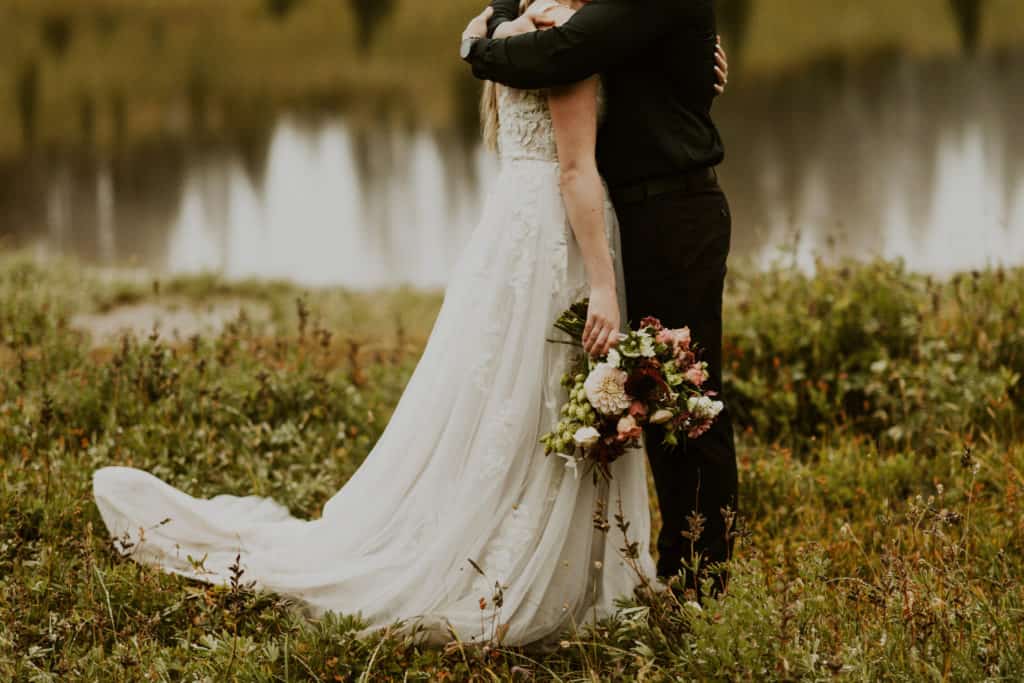
LNT #3: Dispose of Waste Properly
This rule is pretty simple: if you take it in, you take it out. Nothing gets left behind. Period. This includes trash, gum, food, and, yes, even poop (that’s why I recommend going before our adventure!). But on that last one, life happens! If you have to go, dig a cat hole 6-8 inches deep. It should be 200 feet from water, camps, & trails, and can be covered over when you’re done. Toilet paper and feminine hygiene products all need to be taken out not buried in the hole!
Even if it seems like nothing, leaving anything behind can cause a damaging ripple effect. It doesn’t matter if it’s “natural” or “biodegradable” like the flower petals that are no doubt part of your bouquet. If it wasn’t part of the original environment, you shouldn’t leave it there!
LNT #4: Leave What You Find
Your elopement is one of the most exciting days of your life. Naturally, you may feel compelled to take something away from the landscape as a memento of your wedding day (or carving your initials on a tree stump). But please don’t! Rocks, leaves, flowers, shells, sand, and fossils are all part of the natural environment not meant to be taken away from where they exist. Remember, even the smallest changes impact the environment. This also means that you’ll want to minimize any changes you make to the environment. Avoid digging trenches or indentations just to set up arches, tables, or chairs. While you can definitely set these up, do so on durable surfaces like dirt, rock, gravel, and grass. This ensures that anything you set up as part of your ceremony doesn’t impact the environment in the long-term.
Fortunately, photography helps us preserve the visuals of your wedding day without disrupting the environment. That’s why it’s so important to work with a leave no trace photographer if you’re eloping in the great outdoors!
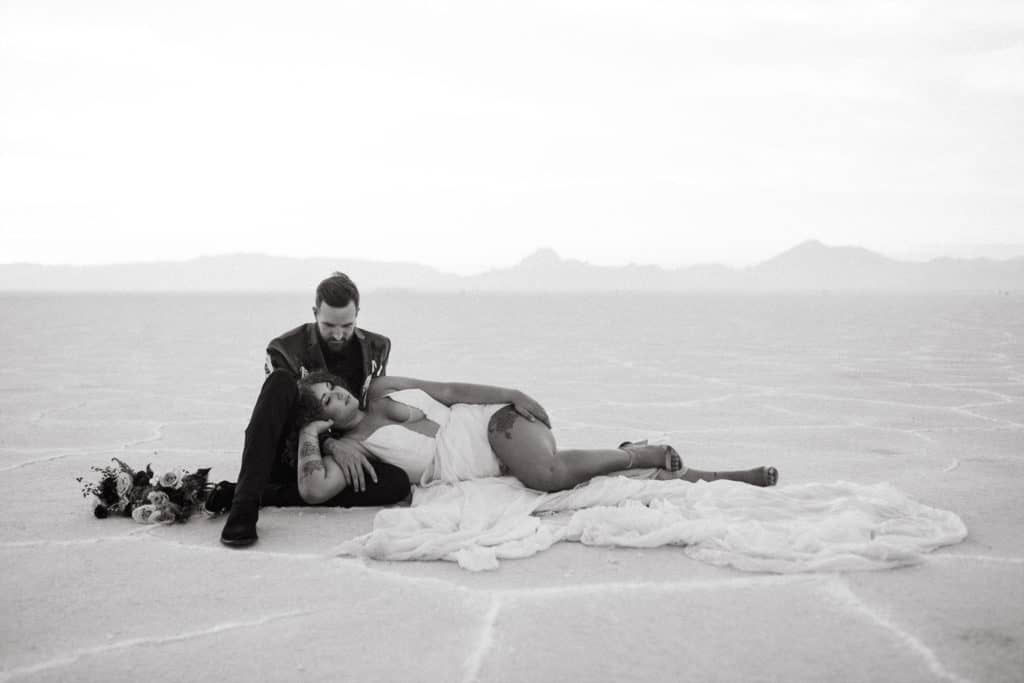
LNT #5: Minimize Campfire Impacts
I love a session that ends with campfire snuggles just as much as the next person. But not every national or state park allows fires, sparklers, or candles. If this is a must on your shot list, double-check that there’s no ban on fires in your desired area. Make sure to respect the rules if there is a ban! Some national parks are very strict on restrictions so this isn’t a step to skip on even if it’s a last-minute elopement plan.
There are even rules about the types of firewood you can bring in. Not all firewood is created equal— some types can even bring in invasive insects that can seriously damage the local ecosystem.
It should go without saying that standing trees should never be cut down. Trees provide shelter to birds & other animals and nutrients to the soil, so even cutting branches can have a damaging effect. If you are gathering branches in the area, use those that are already on the ground. Wood that’s already dead burns more easily, plus it leaves less impact.
In areas that do allow fires, make sure it’s in a designated area not close to anything that could be threatened. Most parks have existing fire rings for you to use, and you’ll want to ensure that your fire all burns to ash with no wood or coals left at the end of the night.
LNT #6: Respect Wildlife
It may be super tempting to interact with wildlife. Do the animals & plants a favor and DON’T. We’ve all seen that video of the guy antagonizing a bison in Yellowstone. And you don’t want to be that person who couldn’t honor & respect nature by leaving it alone. This means that you should avoid getting close to animals or feeding them. Giving animals food (especially anything that doesn’t already exist in their natural environment) can kill them and have the detrimental effect that they’ll no longer fear humans. Believe it or not, it’s safer for animals to fear humans because there are people out there who would harm them.
When it comes to even the most basic elements of your ceremony, it’s super important to be mindful of wildlife in ways you may have never expected to think about. Even if you’re not feeding animals, throwing any confetti made from rice or seeds during that special post-ceremony moment can still harm the environment. Animals may come by later and eat the confetti, which could seriously hurt them. Again, “natural” or “biodegradable” materials still have consequences even if it doesn’t seem like it!
Lastly, at any national or state park you go to, check about bear spray policies before you encounter one in the wild so you know what the protocol is. And, just to be on the safe side, keep your pets on a leash & on a trail if you’re bringing them & the park allows it!
LNT #7: Be Considerate of Other Visitors
It’s not enough to be kind to the environment. You also need to be considerate of other visitors to the park. Although you may be feeling territorial over your chosen area because it’s your wedding day (and it can feel strange to have other people who weren’t invited around!), you’ve chosen a public space to enjoy your day. That means that visitors have just as much of a right to be there as you do! Even if you may feel the impulse, don’t mark off the area as a private space. Keep the focus on your partner and the amazing memories you’ll come away with instead!
Be respectful of people walking by, travel the trails in a single-file line, avoid crazy-loud music, and don’t hog the view for so long that others can’t enjoy it. If we can be kind to each other while out in nature, the national & state parks are even more fun.
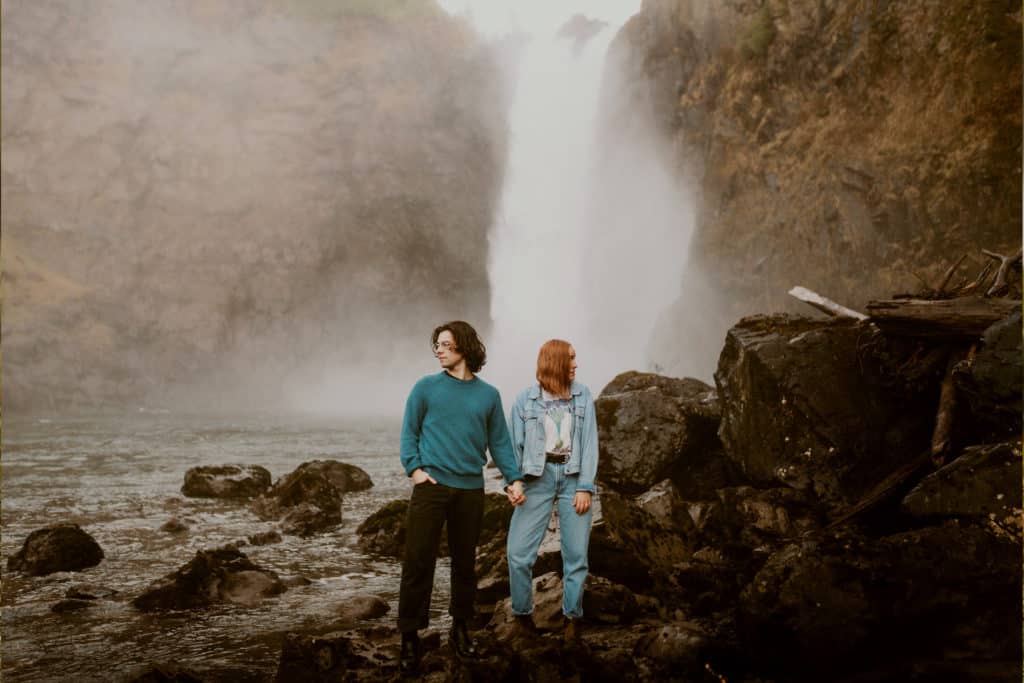
Bonus #8: Don’t Geotag Your Location
When it comes to tagging a specific location on social media, don’t! The rise of Instagram & other platforms has made certain spots in outdoor parks significantly more popular. This means that spots that were once lesser known are now worn & torn by masses of tourists who often disregard the leave no trace principles.
Instead of tagging a specific location, I’d recommend tagging something more generic like “Moab, Utah” (or, better yet, “Utah”) instead of a specific area. That way, those lesser-known spots aren’t so easy to find & you’ll have a super special location for your elopement that even other visitors won’t know how to find.
Are you planning an adventure elopement & ready to make it the best adventure yet? Get in touch to start the conversation. Let's chat about your elopement!
PIN FOR LATER
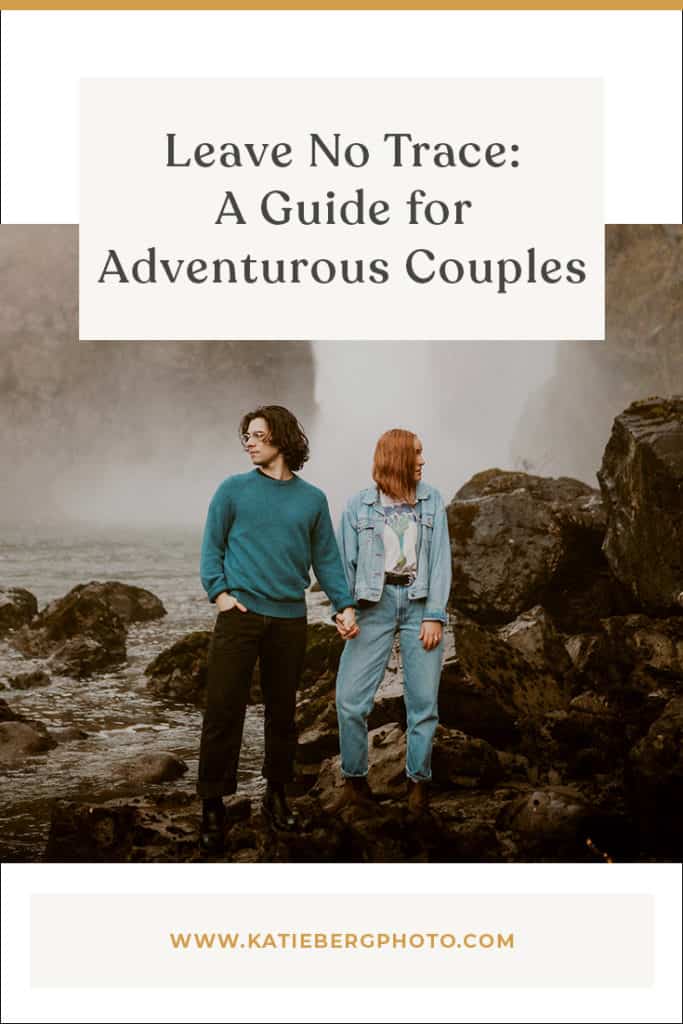


In order to make your dream elopement day happen, it's super important that we connect and that you feel comfortable with me! The best way to do this is to reach out and schedule a call so you can learn more about me and I can learn about you two so i can document what's real + the most important to you.


